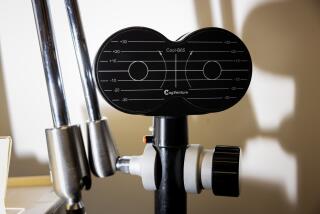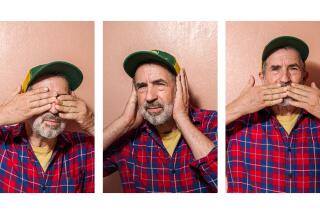Young Brains Shaped by Abuse
MADISON, Wis. — Photos of my children are scattered through my house--in drawers and closets, on tabletops--like leaves in autumn. I don’t know if it’s disorganization or the fact that I like being surprised by stray images: one son wobbling his way through a first soccer game, the other bonelessly asleep on my husband’s shoulder.
I found myself thinking about these sunlit accounts of family life after seeing the video clip of 4-year-old Martha Toogood and her mother. The Toogood tape comes courtesy of a security camera scanning the parking lot of a Kohl’s department store in Mishawaka, Ind. On Sept. 13, it recorded the mother beating the child. What you begin to realize, watching the tape, is how endless 30 seconds can seem.
The little girl is strapped into a safety seat in the car. Or in this case, trapped. The mother looks around, leans in, and then her arm draws back for the first blow. And then the next. Local television stations aired the tape at police request to help find the family. It worked. But even in its flickering graininess, the tape had enough drama to draw national media attention.
Oh, the mother has tried to explain it away. She was having a bad day; she’d been rebuffed on a refund request at the store; she was “mortified” seeing herself on tape. She’s had plenty of opportunities to justify herself on the media circuit, assuring Larry King, for one, that she was “not a monster.”
We don’t know the little girl’s opinion because--rightfully--the child has been hustled into foster care. The system lets the videotape speak for her, and it’s eloquent enough. It will do its work as evidence in the child abuse case now brought against 25-year-old Madelyne Toogood.
And then it will be filed away until it disappears into the back rooms of the court system, a dusty tape from a forgotten crisis. The real record, though, has nothing to do with technology. The most enduring, the most potent memory won’t be in the tape at all. It will be in the child.
It’s a kind of gospel of neuroscience that our brains do their best job of preserving a memory when emotion helps burn it in. We need photographic records of the easy moments because they slip away. Our neurons, those busy nerve cells in our brains, are careless with contentment. They don’t pay close attention. It’s the jolt of shock or grief or fear that etches a memory deepest. So that most of us recall with precision where we stood when we first heard of those hijacked planes on Sept. 11. So that I still remember, as if listening to a digital recording, the slow, weighted sound of my father’s voice on the day 10 years ago that he called to tell me that my nephew was dead.
When it comes to other people’s crises, then, the rest of us need the videotape. Obviously, Martha Toogood doesn’t. What she needs is protection against more of the same. Scientists warn against the risks of accumulating too many such moments into a pattern. Psychological research shows that a parent who routinely threatens or frightens or hurts has real power to shape the way those young brains develop.
To understand just how powerful this effect is--like national tragedy, like death in the family--you have to recognize just how important a parent is to a small child. Actually, we ought to have that one down by now. The most compelling experiments ever, illuminating the inescapable bond between an abusive mother and a child who needs her, were done in the 1960s. Let’s not fool ourselves: We’ve known for decades what a dangerous parent means to a small child.
The studies I’m thinking of were done by the late Harry Harlow, a University of Wisconsin psychologist who used baby monkeys as his model for small children. In this particular set of experiments, he wanted to know what happens to a child whose mother rejects her. He wanted to be very precise about the nature of rejection. So he and his colleagues built a series of “evil” robot mothers. They had soft padded bodies and blandly smiling faces. But they were evil, all right. One shook infants until their teeth rattled. One was spring-loaded to hurl the baby animals away. The most infamous came equipped with brass knobs that would ram into a baby as it cuddled in.
Harlow and his colleagues expected that they would end up with neurotic babies. And they did. But, unexpectedly, they also produced devoted ones. No matter what the mothers did, the babies always came back. A baby monkey would pick itself up, wait until the knobs retracted, and once again wrap itself around the mother. It would cling hopefully to the shaking mother, trying to stay on. The infants seemed tireless in their willingness to try again to persuade their mothers to, well, be mothers--be loving, be safe.
Those studies represent only a fraction of Harlow’s sometimes lovely, sometimes explicitly painful research into parent-child relationships. He believed that his other work, demonstrating the importance of a loving touch, mattered more in everyday life. No one grows up whole and healthy, he insisted, without “a solid foundation of affection.” But he was emphatic about the value of the darker studies. Not every child gets that foundation; some get the opposite, obviously. And yet all children need loving adult support. If you’re going to study love, Harlow insisted, you have to study all its aspects.
There can be an almost gut level response today, after years of consciousness-raising about animals, to the plight of those baby monkeys. But when Harlow did this work, there was no aggressive animal rights community to criticize it. There was no 21st century sense of ethics in animal laboratories. At the time, the real shock value in the evil mother study was what it said about the strength of the parent-child bond and the sometimes terrible power in that relationship.
We forget that until the mid-20th century, psychology was dominated by experts who insisted that affection wasn’t important in parenting. They even argued that too loving a parent would damage a son or diminish a daughter. “There are serious rocks ahead for the overkissed child,” wrote 1920s child-care guru John Watson. It took years, it took decades and it took Harry Harlow’s undeniable, in-your-face studies of the impact of loveless parenting to change that.
Perhaps we would be smarter about parenting now if science had gotten the point earlier. Still, since the Harlow days, psychology has leaped forward in illuminating our need for that foundation of affection, and nurturing, and security. No psychologist argues that parents need to be perfect, that we permanently damage a child through the occasional gust of impatience or anger. But the emphasis there is on occasional. Consider once again the accidental gotcha of that parking lot security tape. Does anyone believe that this was the one, the only time that Martha Toogood’s mother took out her frustrations on her child?
Researchers such as Robert Sapolsky, at Stanford University, have shown that a young brain does its desperate best to cope with an environment of fear and threat. It restructures. It notches up the stress response. It keeps the body poised for flight. It floods the nervous system with angst. When the child grows up, the adult brain is beautifully designed to hover right on the edge of panic. Although there’s a certain hyper-alertness in that, Sapolsky and his colleagues see no advantage. They see cost. Stress-related hormones and neurotransmitters put real wear and tear on the system and have been linked to destruction of brain cells and to memory loss.
And abuse wears away at the potential of the child in other ways. Psychologists once thought that all people had an innate ability to read facial expressions, were born knowing how to register a friendly smile and an angry frown. Now studies contradict that. Experiments instead show that abused children can be face-blind. Consistently, these boys and girls will read anger into a smile, see real threat in even the mild irritation of a raised eyebrow. Their brains show a sudden furious leap of response, one that doesn’t register in children from more supportive homes.
It’s the photograph problem again. As if that videotape, that moment when the mother’s arm swings back in anger, could play itself in an endless loop, override a friendly gesture or a casual one. The brains of these children can become structured for that override. And although research, from Harry Harlow on, suggests that other, better relationships can help correct such reactions, ask yourself whether that jittery, stress-prone reaction helps the Martha Toogoods of the world make friends?
So “I had a bad day” doesn’t make it as an excuse, not for Martha Toogood’s mother, not for any of us. Let’s go ahead and file the videotape away. And, yes, let’s give that child a break from home. I hope she has a chance for some silly, happy moments, gets to pile up some of those bright, casual photographs. Memories count. Let’s not forget that.
*
Deborah Blum is a Pulitzer Prize-winning science writer and the author of “Love at Goon Park: Harry Harlow and the Science of Affection.”






